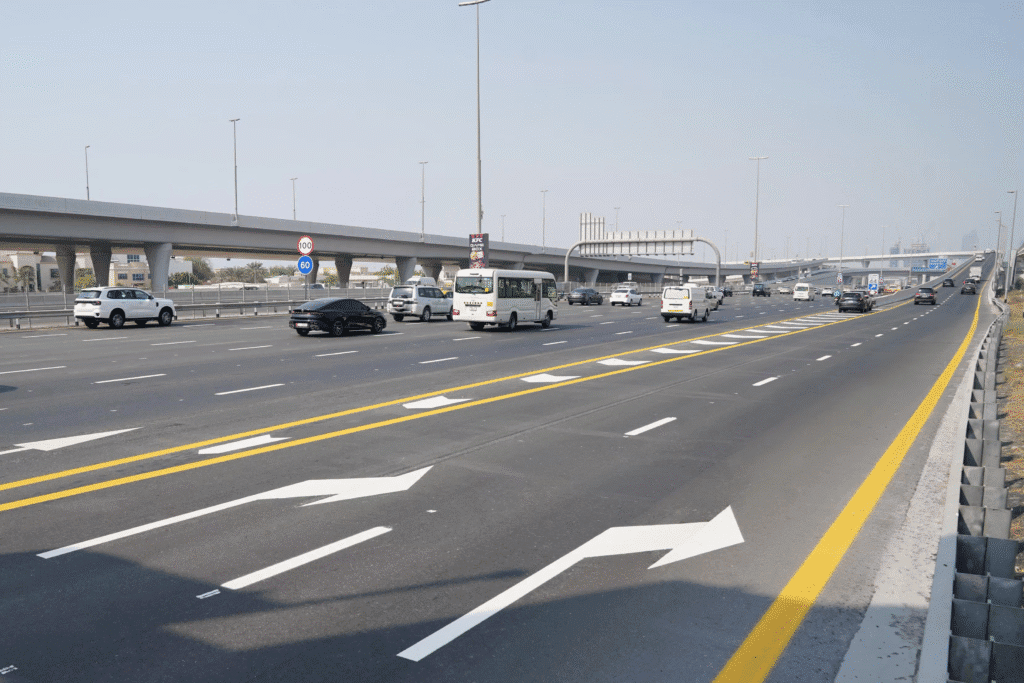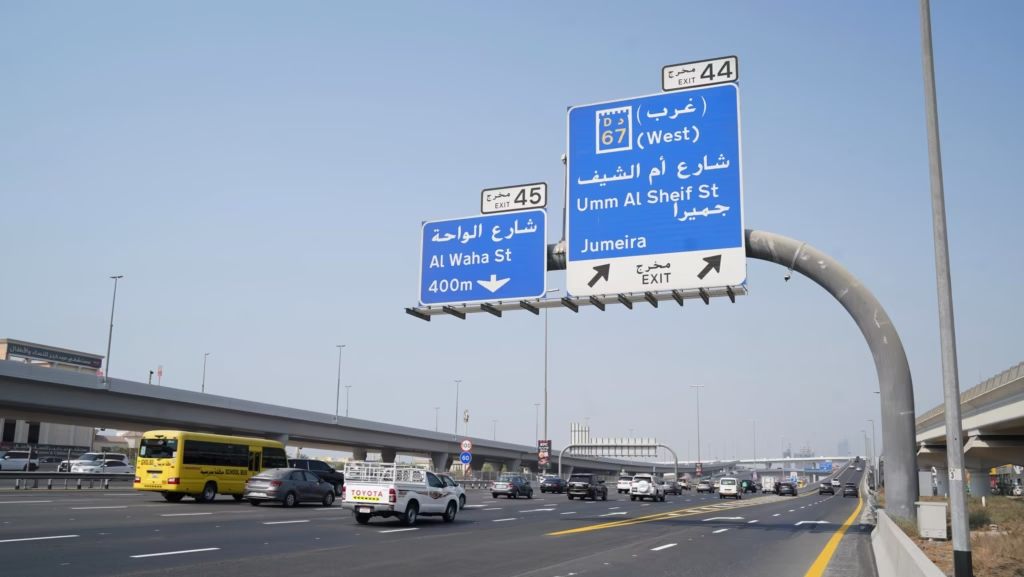Dubai’s Roads and Transport Authority (RTA) has successfully completed a major road widening project on Sheikh Zayed Road, one of the busiest and most important highways in the city. This 700-meter stretch near the Umm Al Sheif Street exit has been expanded from six lanes to seven in the direction of traffic flow. The improvement increases the road’s capacity by approximately 16%, allowing it to handle up to 14,000 vehicles per hour. The project is a strategic step to enhance traffic efficiency, reduce congestion, and improve commuter safety along one of Dubai’s key traffic corridors.
Sheikh Zayed Road serves as the backbone of Dubai’s road network. It connects major residential areas, commercial districts, and iconic landmarks such as the Burj Khalifa, Dubai Mall, and Dubai Marina. As the city has grown, traffic congestion has become a frequent challenge, especially during peak hours. The Umm Al Sheif exit, in particular, has historically been a bottleneck, with vehicles slowing down due to the convergence of multiple traffic streams. This road widening aims to alleviate these challenges, streamline vehicle flow, and provide a safer driving experience.
The Importance of the Road Widening Project
Road infrastructure is one of the key pillars of Dubai’s development strategy. A city with modern infrastructure attracts investment, supports tourism, and improves the quality of life for residents. By widening Sheikh Zayed Road near Umm Al Sheif Street, the RTA addresses a crucial traffic hotspot while anticipating the city’s future growth.

Commuters in Dubai face heavy traffic during morning and evening peak hours. Congestion at critical junctions like Umm Al Sheif can cause delays that ripple across the entire city, impacting productivity and increasing stress levels for drivers. By adding a seventh lane, the RTA has effectively increased road capacity, reduced potential congestion points, and provided a smoother driving experience.
In addition to easing traffic, the road widening contributes to improved safety. Narrow lanes and overlapping traffic often increase the likelihood of accidents. The expansion creates more space for vehicles, reduces the chances of sudden lane changes, and ensures safer merging and exit points.

Key Features of the Road Widening Project
The 700-meter road widening project incorporates several important features aimed at enhancing traffic flow and commuter convenience:
- Expanded Lane Capacity: The stretch has been widened from six lanes to seven in the direction toward Umm Al Sheif Street. This extra lane increases the overall capacity and ensures smoother vehicle movement.
- Traffic Flow Optimization: The redesign of the entry and exit ramps reduces congestion at the junction, enabling vehicles to merge seamlessly without causing slowdowns or backups.
- Enhanced Safety Measures: New signage, road markings, and lane adjustments improve visibility and reduce the risk of accidents. This is especially important for high-traffic areas during peak periods.
- Increased Vehicle Handling: With the additional lane, the highway can now accommodate up to 14,000 vehicles per hour, which is essential for both local commuters and long-distance travelers coming from or going to Abu Dhabi.
- Urban Mobility Support: The project aligns with Dubai’s broader transportation goals, including smart mobility solutions, efficient road networks, and sustainable urban planning.
The Impact on Daily Commuters
The road widening project offers significant benefits for daily commuters. For drivers using Sheikh Zayed Road to reach central business districts, the expansion is expected to shorten travel times and reduce stress during peak periods. The extra lane allows smoother transitions at the Umm Al Sheif exit, minimizing bottlenecks that previously caused stop-and-go traffic.
Public transportation users also benefit indirectly from this upgrade. Buses and taxis traveling along Sheikh Zayed Road will experience fewer delays, making public transit a more reliable option for residents. Reduced congestion also supports Dubai’s efforts to promote eco-friendly transport, as smoother traffic flow can reduce emissions from idling vehicles.
Beyond commuters, logistics and delivery services will see operational advantages. Delivery trucks and freight carriers moving goods along this stretch of Sheikh Zayed Road will enjoy faster transit times, contributing to overall efficiency for businesses that rely on timely deliveries.
Technical Aspects of the Road Widening
The RTA approached the road widening project with precision engineering and planning to ensure minimal disruption during construction. A multi-phase plan allowed the road to remain functional while lanes were added and improved. Key technical aspects included:
- Careful Lane Redesign: Each lane was carefully planned to maintain adequate width while improving traffic flow.
- Pavement Reinforcement: The additional lane required high-quality asphalt to ensure durability, withstand heavy traffic loads, and prevent long-term maintenance issues.
- Drainage and Safety Measures: Modern drainage systems were integrated to prevent waterlogging during rainfall, and guardrails were updated to enhance safety.
- Traffic Management During Construction: Temporary signage, diversion lanes, and controlled work zones ensured that traffic continued to move safely while the construction work was in progress.
The project was completed without major interruptions to daily commuters, reflecting the RTA’s commitment to efficient project execution.

Supporting Dubai’s Growth
Dubai has experienced rapid population growth and urban development over the last decade. With new residential, commercial, and leisure projects emerging, road infrastructure must keep pace. The road widening at Sheikh Zayed Road near Umm Al Sheif Street is a proactive measure to meet current demand and anticipate future traffic increases.
Investing in roads is not just about handling more vehicles—it is about creating a city that functions efficiently. Reduced traffic congestion leads to more predictable travel times, better emergency response, and improved quality of life for residents and visitors.
The RTA’s focus on such infrastructure improvements reflects Dubai’s commitment to being a world-class city. By planning ahead and enhancing key roads like Sheikh Zayed Road, the city ensures that its transportation network remains capable of supporting long-term growth.
Future Road Development Plans
The completion of this road widening project is part of a larger RTA strategy to modernize and expand Dubai’s road network. The authority has several plans in place for the coming years:
- Further Lane Expansions: Other congested sections of Sheikh Zayed Road are slated for lane expansions to enhance overall road capacity.
- Smart Traffic Solutions: The introduction of intelligent traffic management systems will allow real-time monitoring of congestion, helping authorities adjust traffic signals and lane use dynamically.
- Integration with Public Transport: Road improvements are being coordinated with public transport expansions, such as metro and bus services, to ensure seamless mobility for all residents.
- Sustainability Initiatives: Future projects will incorporate eco-friendly construction materials and designs to reduce carbon footprint while maintaining high-quality roads.
Community and Economic Benefits
The road widening project offers broad benefits beyond reducing congestion:
- Economic Efficiency: Faster commutes and improved transport for goods directly support businesses by saving time and reducing operational costs.
- Enhanced Safety: Better lane management and fewer bottlenecks contribute to a lower accident rate.
- Urban Connectivity: The project strengthens connectivity between residential areas, business hubs, and leisure destinations, making Dubai a more accessible and convenient city.
- Environmental Impact: Smoother traffic reduces stop-and-go driving, which in turn lowers emissions, supporting Dubai’s environmental sustainability goals.
Public Feedback and Reception
Initial reactions from commuters have been positive. Drivers report smoother transitions at the Umm Al Sheif exit and a noticeable reduction in traffic congestion during peak hours. Residents appreciate the proactive approach taken by the RTA, which balances ongoing urban growth with infrastructure upgrades.
This project demonstrates that thoughtful planning and modern engineering solutions can make a tangible difference in everyday life. It also underscores the importance of investing in infrastructure as a means to support both economic activity and the well-being of residents.
Conclusion
The completion of the 700-meter road widening on Sheikh Zayed Road near the Umm Al Sheif Street exit is a significant milestone for Dubai’s transportation network. The project addresses a critical congestion point, increases road capacity by 16%, and provides smoother, safer commutes for up to 14,000 vehicles per hour.
By widening the road and improving traffic flow, the RTA has not only resolved immediate challenges but has also prepared for future growth. This project reflects Dubai’s commitment to creating a city that functions efficiently and safely for residents, businesses, and visitors alike.
As the city continues to expand, projects like the Sheikh Zayed Road widening are essential for ensuring that Dubai remains a global hub for business, tourism, and innovation. With improved infrastructure, enhanced safety, and reduced travel times, the road widening near Umm Al Sheif Street sets a benchmark for future development and demonstrates Dubai’s commitment to sustainable urban mobility.
Do follow UAE Stories on Instagram
Read Next – Graduate Plant Operator Programme UAE: Exciting Opportunity for Emirati Engineers















